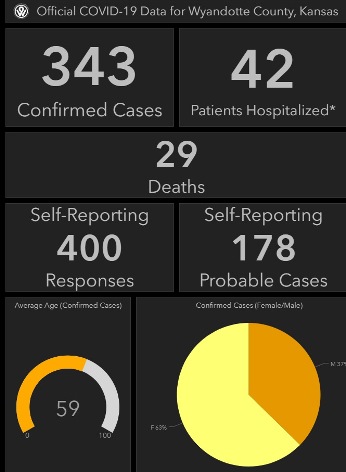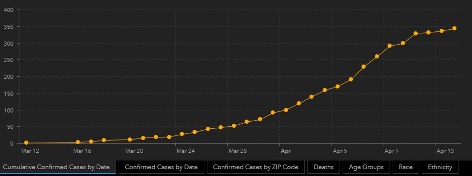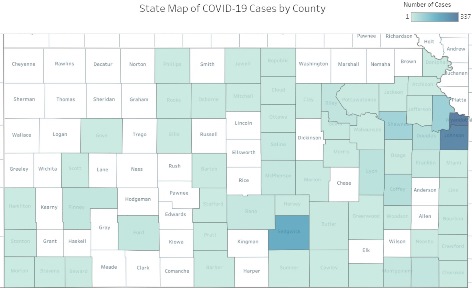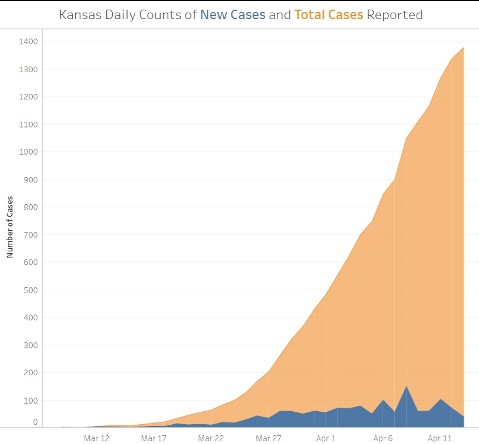

Wyandotte County reports 343 positive cases, 29 total deaths
The national discussion around COVID-19 is starting to change to a gradual return to a more normal, or a different normal way of living, and doctors at the University of Kansas Health System today offered their opinions about how people may be dealing with the coronavirus in the future.
In Wyandotte County, 343 total positive COVID-19 cases were reported on Tuesday at 12:30 p.m., with 29 deaths, according to the Unified Government’s COVID-19 website. Of 400 persons who sent in information to the UG’s self-reporting website, about 178 of those were considered to be probable cases, the website stated. The state of Kansas reported 1,426 positive cases on Tuesday morning, with 69 deaths.
The UG’s COVID-19 website showed that new case numbers were not rising as fast as they had last week.
Dr. Dana Hawkinson, medical director of infection control and prevention for the KU Health System, said that while projections are getting better, they didn’t want to be too optimistic, because the projections could change.
Trials for vaccines are going on, and if a vaccine is found, it could take 18 months to get to the public, Dr. Hawkinson said.
KU Hospital currently has 29 inpatients, with 12 in the intensive care unit and nine on a ventilator, about the same as yesterday’s report, he said. Dr. Steve Stites, chief medical officer at KU Health System, noted it has decreased slightly, as there were 14 on ventilators and up to 34 patients at one time previously.
Dr. Hawkinson said the KU Health System is actively preparing for a trial for donors who want to give plasma and convalescent serum. Dr. Stites said that this program probably would pool together plasma from more than one donor, then give it to people who are sick with COVID-19 and not recovering well. At this time, it would not be available to those who were not sick or to those who were mildly sick. Results would be reported to a national database and available for study later.
Most people who have had COVID-19 would mount an antibody response in 11 to 14 days, according to Dr. Hawkinson. Donors who have recovered from COVID-19 would have to wait some time before donating, as some of them have been getting an early and a later bout of illness, according to Dr. Stites. Donations would not be made through KU Health Systems; possibly they would be through the blood centers.
The idea of herd immunity currently is being discussed. As a disease spreads through a big population, enough people may get it until the disease doesn’t pass effectively – it runs into people who have already had it and are immune, and it isn’t passed on.
Dr. Stephen Lauer, a pediatrician and associate chair of pediatrics at KU Health System, said that kids as a group don’t seem to be getting as sick with COVID-19 as older patients. It may not be possible to tell that they have it, as there are some persons who don’t have symptoms, he said.
“The problem with building herd immunity right now is we don’t have any idea of how big the herd is,” Dr. Lauer said. “We don’t know how many have been infected, how many have recovered, and so it’s really not possible to get a reliable sense of herd immunity.”
The best way to get to immunity now is through immunizations that may be developed, he said, to avoid severe illnesses and deaths.
Dr. Stites said for people who have diseases of the immune system, heart failure, transplants or chronic lung disease, opening up society again is a real fear as they may come into contact with people who have the disease.
Herd immunity generally requires about 80 to 90 percent of the population to have had the disease and recovered, according to Dr. Hawkinson, or for vaccinations of that amount of the population.
“We think only about 1 or 2 percent of Kansas Citians in our area actually have had Sars-Cov2 (the novel coronavirus),” Dr. Stites said. “That’s a pretty low proportion. We are seeing the flattening of the curve.”
Everyone in this area has demonstrated to the nation how to flatten the curve, he said. Although they’re not sure if they’ve seen the peak of the curve, they have flattened it, he said.
“Folks have sheltered in place, stayed at home, maintained their distance, which we wanted you to do,” he said. If they hadn’t, the health care systems would have been overwhelmed, with more problems, he added.
While Wyandotte County and Kansas are still under a “stay-at-home” order for COVID-19, a national discussion is ongoing about reopening society. The governor has said she planned to extend the “stay-at-home” order next week.
If there are not enough people who have been infected or vaccinated, then it becomes easy to pass the virus, Dr. Stites said, when society opens back up.
While it is a scary thought for people at home with other conditions, it’s still possible for individuals to remain sheltered, he said. According to Dr. Stites, just because other parts of society have opened doesn’t mean that individuals can’t still practice good handwashing, keep a distance from others, not touch their face, avoid large crowds and wear a mask until the time there is better therapy, can predict the risk factors, and vaccinations are available.
“There are things you can do to stay safe even as society starts to open back up,” Dr. Stites said. “When we start to reopen society, we have to do it in a cautious, logical and thoughtful format.”
Dr. Lauer added it was important for people with chronic conditions to work with their doctors to keep it under control.
Dr. Lauer said that while they are currently fighting one infectious disease, COVID-19, it also was important to keep up the herd immunity on all the other childhood diseases. It is important to give vaccines to infants and toddlers against other diseases, he said, as he wouldn’t want to see the return of preventable diseases such as mumps and measles.
As society starts to reopen, Dr. Stites said it may not look the same right away. Residents need to keep up the social distancing, washing their hands, not going out in large gatherings for a while, until they have effective immunizations, he said.
“COVID-19 is going to be with us a while,” he said, “it’s not going to go away, and that’s a challenge to all of us.”
“If we work to stay safe, even as we reopen this world, we can beat COVID,” Dr. Stites said.
To see a video of the KU doctors’ news conference, visit https://www.facebook.com/kuhospital/videos/1488164271356665/
The UG’s COVID-19 webpage is at https://alpha.wycokck.org/Coronavirus-COVID-19-Information
The Kansas COVID-19 resource page is at https://govstatus.egov.com/coronavirus.
The CDC COVID-19 page is at https://www.cdc.gov/coronavirus/2019-nCoV/index.html.


